What is an Immersive Event and How to Create One

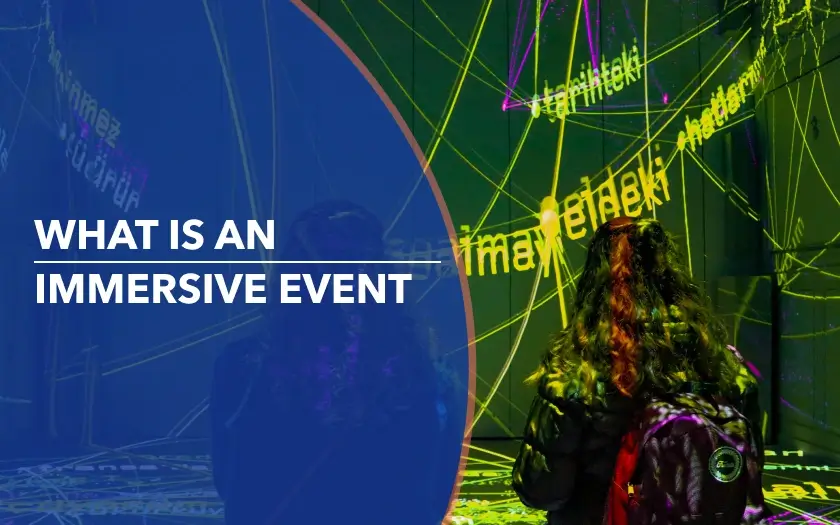
Events are no longer gatherings structured around stages, booths, or PowerPoint decks. They are becoming immersive ecosystems where attendees are pulled out of passive observation and into an experience that’s sensorial, participatory, and story-driven.
Whether you’re planning a brand activation, an internal training, or a hybrid product launch, immersive events aren’t just a passing trend; they’re becoming an increasingly valuable way to engage modern audiences. The question isn’t whether to consider them, but how to design them in ways that feel meaningful, achievable, and true to your goals.
{{table-of-contents}}
What is an Immersive Event?
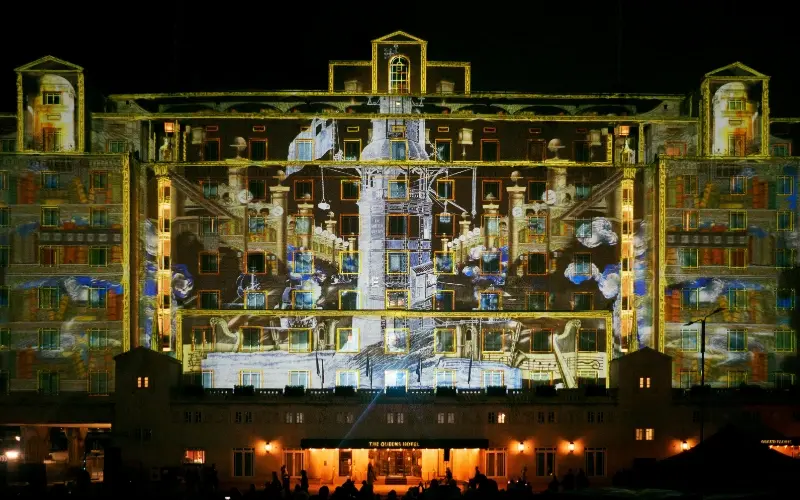
At its core, an immersive event is designed to fully engage the attendee—visually, physically, emotionally, and often even intellectually. It’s not just about impressive screens or tech gadgets; it’s about creating a space where people actively participate.
The signature markers of an immersive event? They are:
- Sensory layering: Atmospheric lighting, ambient soundscapes, tangible textures, even curated scent and taste.
- Narrative structure: A thematic arc that carries the attendees through a journey.
- Interactive touchpoints and agency: Attendees make choices, explore, touch, and interact.
- The tech: AR portals that turn signage into living media, projection mapping that transforms blank walls into dynamic canvases, and XR platforms that let users experience worlds that don’t physically exist but feel very real.
You’ve seen them already at a Van Gogh exhibition where brush strokes spill out from the canvas and into the room, surrounding you in light and texture. A Stranger Things activation where fans don’t just watch the story but walk through the Upside Down. Escape rooms, immersive theaters, and sensory museum installations that invite full-body engagement. Even virtual conferences hosted on virtual event platforms like Remo, where gamified networking and spatial audio turn remote attendance into an interactive experience are immersive in nature.
And increasingly, real-time XR integrations, such as mobile AR, overlays guiding visitors through a climate change exhibit, or AI avatars co-hosting panels in digital spaces, are becoming core to how we build immersive events.
The key thing to remember is immersive experiences are as much about engagement as they are about spectacle.
Why Immersive Events Work
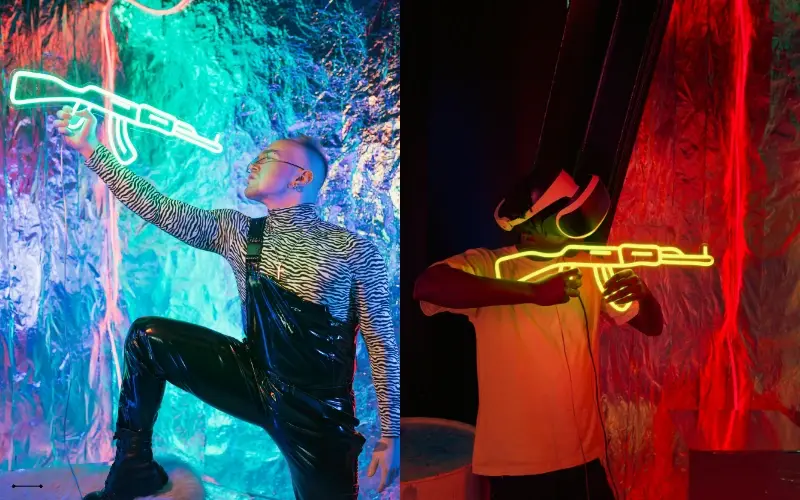
Immersive events trigger the three drivers that have always made experiences stick: presence, emotion, and memory. When you actively participate in something by walking through it, shaping it, reacting to it, it lands differently. You remember it longer. You share it more. You connect with it more deeply.
This is where the post-COVID shift matters. In-person experiences are back, yes, but the bar is higher. People crave meaning, connection, and personalization. And immersive events meet them there.
For event organizers and brands, this translates into tangible returns:
- Higher social media shareability (especially if selfie stations and surprise-and-delight moments are built in)
- Improved brand recall and loyalty, not because people heard or saw your message, but because they lived it
- Increased dwell time and deeper engagement, leading to more conversions in product or mission-focused events
How to Plan an Immersive Event
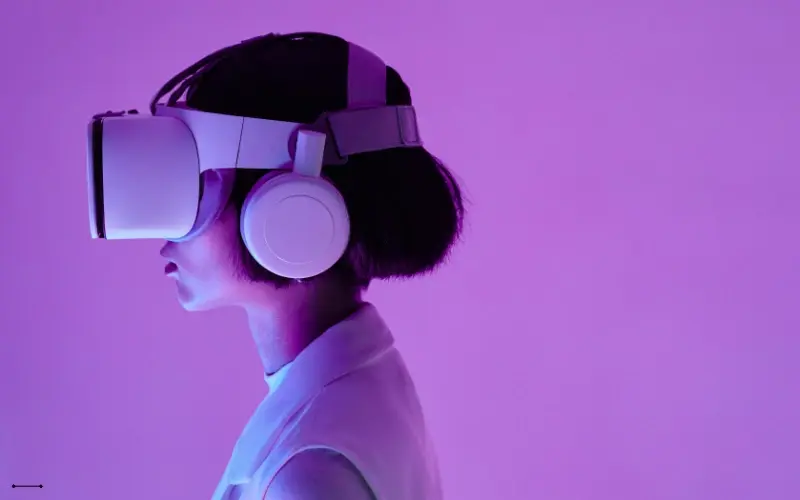
From VR headsets and AR overlays to AI-powered storytelling, the tools to transform events are advancing fast. But tech alone doesn’t make an experience immersive. It takes intention, narrative, and a deep understanding of how people want to engage.
So how do you plan one? Let’s break it down step by step:
1. Define the Goal and Audience
Not every immersive event is built for the same outcome. Are you trying to educate? Launch? Entertain? Raise awareness? Clarity here is critical, because the structure of your experience (and the tools you use) will hinge on what you're trying to deliver.
Then map it to the audience: Are they tech-forward or more traditional? Are you welcoming students, professionals, gamers, corporate leaders?
Immersion doesn’t require bleeding-edge gear. It requires relevance. And that begins with understanding your target audience.
2. Build a Narrative Framework
Storytelling is central to creating a successful immersive event. A strong narrative is your glue. It gives the experience direction, pacing, and emotional rhythm.
Start with a setting. Create an arc: a welcome, a conflict, a climax, a resolution. Whether you’re launching a product as the “hero” or designing a journey through time, a clear theme makes every touchpoint feel intentional.
Even in hybrid event or virtual event formats, this narrative scaffolding is what turns “just another online meeting” into a guided, thoughtful experience.
3. Choose the Right Venue (Physical or Virtual)
When it comes to planning an immersive event, spatial flexibility matters. Flexible spaces like warehouses, tents, or black-box studios offer the versatility to manipulate sound, light, and layout. But so do virtual conference platforms, like Remo, with spatial interactivity and customizable floor plans and avatars.
In both cases, the key is flow. Can attendees move comfortably? Does the space support transitions from one phase of the experience to another? Are there zones for pause and reflection, or is it sensory overload?
Ensure that your venue supports the creative, technical, and accessibility demands of the format.
4. Design the Environment
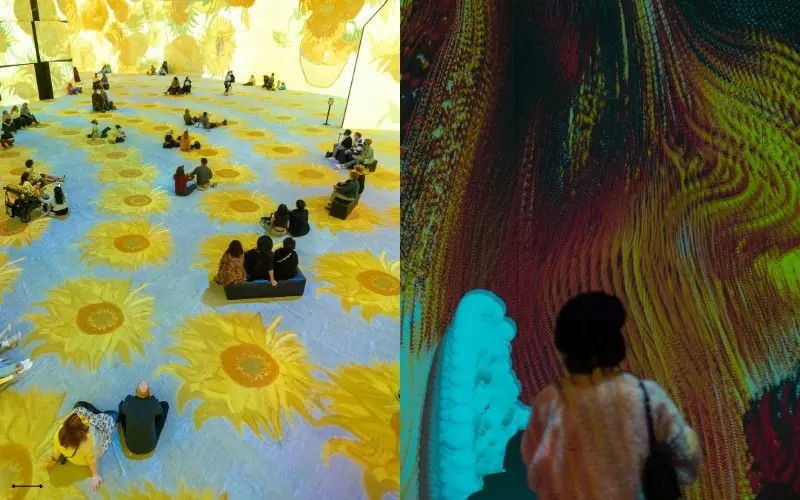
Environmental storytelling transforms spaces into experiences. You must think beyond décor because for an immersive event you're constructing a world. You can use:
- Set design to anchor the theme.
- Lighting and soundscapes to shape mood.
- Scent to build memory anchors.
- Interactive signage, multi-textured materials, and layered visuals to keep attendees exploring.
Avoid cramming everything in one spot. Create zones or chapters and let attendees flow.
5. Integrate Technology Intentionally
This is where things get tricky. Technology is powerful, but if it’s clunky or distracting, it can get overwhelming. So use it where it serves a purpose for your immersive event, such as:
- Projection mapping to extend set design.
- AR triggers via QR codes on walls or programs. This is ideal for mobile-driven layers.
- VR simulations to let attendees experience environments or scenarios they couldn’t otherwise access.
- Virtual platforms for hybrid events with breakout zones and spatial networking.
- Consider AI-driven assistants or avatars for multilingual support or real-time content generation.
Yes, XR headsets like Vision Pro or Meta’s Ray-Ban glasses grab attention and are great for small sections of an event. But mobile-based AR remains the most frictionless and accessible technology for on-site and hybrid activations. If you want to explore how XR and AI are evolving in the events space, the report ‘State of AI and XR in Events’ by Events.com breaks it all down. From trends to use cases, it's all in there. Just download and dive in.
6. Create Interactive Touchpoints
Immersion at events thrives on interaction. It’s not just tech-driven, but human-driven too.
Consider:
- Live performers who guide attendees through narratives
- Gamification for events through elements like quests, stamps, or scavenger hunts
- Interactive displays, polls and quizzes, or storytelling triggers
- Photo/selfie spots designed with framing and lighting in mind
7. Align Teams and Logistics
Organizing an immersive event requires cross-functional coordination and alignment. Core roles may include:
- Experience Director (owns the vision)
- Tech Lead (handles hardware/software integrations)
- Safety Officer (essential for live events with moving parts)
- Narrative Designer or Scriptwriter
Run technical rehearsals. Validate every transition, activation, and backup protocol to catch broken loops, awkward transitions, or tech hiccups.
8. Measure and Capture Feedback
Establish event metrics that reflect both the emotional and operational success of your immersive event. Aim for metrics like:
- Time spent per zone
- Engagement rates (number of interactions, scans, shares)
- Social media coverage
- Post-event surveys and attendee satisfaction scores
QR codes, NFC tags, and feedback kiosks are low-friction tools. You can also capture content throughout the event because these moments often become assets for future marketing.
Ultimately, the true power of immersive technology lies not in what’s possible, but in what’s purposeful. But purpose alone isn’t enough, bringing it to life requires planning. And immersive events come with their own unique challenges. Knowing what to look out for can help you avoid common pitfalls and create an experience that truly resonates.
Common Mistakes to Avoid
Even the best concepts can fall flat if execution misses the mark. Watch out for these common mistakes when planning an immersive event:
- Over-reliance on tech without emotional depth: Just because you can add VR, AR, or AI doesn’t mean you should, at least not without intention. Immersive events succeed when they connect on a human level.
- Lack of narrative cohesion: A scattered set of “wow moments” won’t stick unless there’s a clear story tying them together. Your event should guide attendees through a structured arc, not isolated attractions.
- Overcrowded spaces that lead to fatigue: Overstuffed rooms, constant stimuli, or complex navigation can lead to sensory fatigue. Leave breathing space, physically and mentally, so that key moments land and participants feel engaged, not drained.
- Ignoring accessibility: Immersive should also mean inclusive. Consider mobility, hearing, vision, neurodiversity, and language needs in your design.
- Skipping post-event follow-up: Whether it’s through content recaps, interactive summaries, or continued engagement touchpoints, following up helps sustain the connection you’ve built and gather real insights into how well your immersive experience landed.
Intent. Immersion. Impact.
The most memorable events don’t just impress—they immerse. It’s not about packing in more tech or pushing the loudest spectacle, but crafting a space where every interaction feels intentional, every moment adds to a story, and attendees feel part of it, not just present in it.
If you're aiming to host something that resonates at that level, Remo gives you the canvas to do it beautifully. Spatial video, customizable layouts, and interactive features, all designed to support experience-led events with real human connection.
Ready to go immersive? Book a demo today.
Frequently Asked Questions about what are Immersive Events
1. How does immersive storytelling work in events?
It brings together space, sound, visuals, and interaction to create a unified emotional journey. It’s not just a theme, but a story people step into.
2. Do I need VR/AR hardware to make an event immersive?
Not necessarily. Immersion is more about thoughtful design and engagement than flashy tech. AR/VR can enhance the experience, but aren’t essential.
3. How do I measure the success of an immersive experience?
Look beyond attendance and track engagement depth, emotional resonance, dwell time, and what attendees say and share after the event.







.webp)




















